5 Things Your Baby Should Be Able to Do Before Starting Solid Foods
- Why so many doctors recommend starting solid foods too early…and what to do if your doctor is pressuring you to spoon-feed now too
- What the most important reliable sign of readiness to eat is after turning 6 months old…and why it has nothing to do with the extrusion reflex
- How to assess whether or not your baby has the head and neck control and the trunk strength to support a safe swallow.
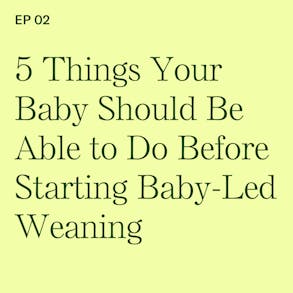
LISTEN TO THIS EPISODE
Episode Description
Not all babies are ready to start solid foods right at 6 months of age. Listen to learn about 5 key milestones your baby should have down pat before you start solid foods.

Links from This Episode
- Baby-Led Weaning with Katie Ferraro program with the 100 First Foods™ Daily Meal Plan, join here: https://babyledweaning.co/program
- Baby-Led Weaning for Beginners free online workshop with 100 First Foods™ list to all attendees, register here: https://babyledweaning.co/baby-led-weaning-for-beginners
Other Episodes Related to This Topic
- Episode 119 - Premature Babies: How to Estimate & Adjust Age for Starting Solids
- Episode 158 - How Premature Babies Can Succeed with BLW with @doctorterrimd Terri Major-Kincade, MD
- Episode 110 - Catch-Up Weight: Why Starting Solids Early Will Not Help Your Baby Gain Weight with Rosan Meyer, PhD, RD
- Episode 144 - What Did Babies Eat Before Baby Food was Invented? with Amy Bentley, PhD
- Episode 109 - I Started Purees Too Early: Should I Stop Before Switching to BLW?
- Episode 141 - BLW Basics: Is My Baby Ready to Start Solid Foods?
- Episode 147 - BLW Basics: Help! Nobody Around Me Understands Baby-Led Weaning
- Episode 199 - Beginner's Guide to Baby-Led Weaning: Starting Solid Foods Safely with BLW

Latest Episodes
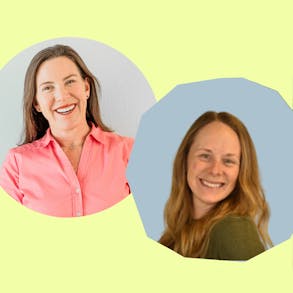
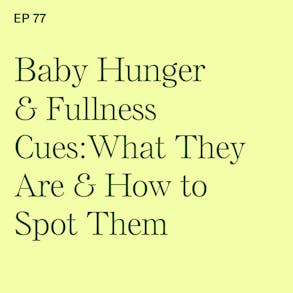
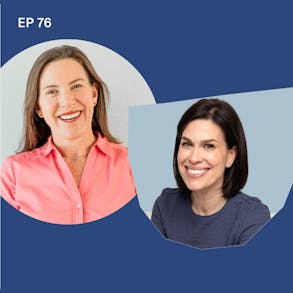
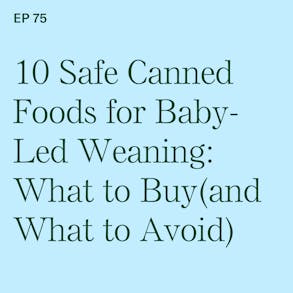
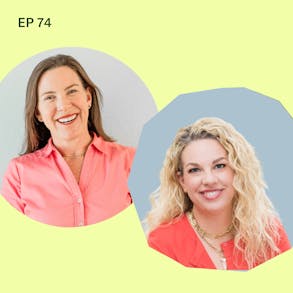
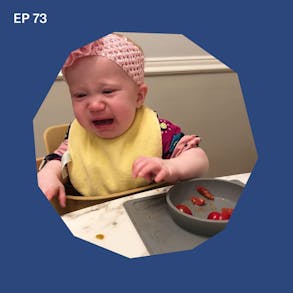
Katie Ferraro (0s):
And it is much safer and much more fun to feed a baby who is ready to eat versus trying to make one who isn't eat. I mean, just cause you can push a spoon or squeeze a pouch into a baby's mouth before she's ready. Doesn't mean that you should. Hey there, I'm Katie Ferraro, Registered Dietitian, college nutrition professor, and mama of seven specializing in baby led weaning. Here on the Baby-Led Weaning Made Easy podcast I help you strip out all of the noise and nonsense about feeding, leaving you with the competence and knowledge you need to give your baby a safe start to solid foods using baby-led weaning.
Katie Ferraro (42s):
Hello and welcome back to the Baby-Led Weaning Made Easy podcast. This is your host, Katie Ferraro, Registered Dietitian and mom of seven specializing in baby-led weaning. I love feeding babies, you guys, but my goal here is to make it easy for you to do baby-led weaning, but do it safely. Now, when it comes to safety, we really cannot put the cart before the horse, meaning you can't get your baby to safely eat real food before he or she is ready. And so that's what this episode is all about. I will be defining the five things your baby should be able to do before you start solid foods.
Katie Ferraro (1m 24s):
Now, once your baby hits all five of these things, he or she is ready to feed, but you can't do it ahead of time. It's just not safe. And not only is it safer to wait to feed a baby, who's really ready to eat. It's also way more fun. Trust me, take it from a mom who struggled infinitely with spoonfeeding my oldest, because I started too soon before she was ready. Now, some of you might be in the same boat. It's too early, but you're excited or people have told you your baby's big. So your baby should start solid foods early, or your baby is small. So your baby should start solid foods early. I'm going to help you dispel all those myths because I know you're excited and I know you want to start solid foods, but again, you really can't do any of this safely before your baby is ready.
Katie Ferraro (2m 9s):
And I get it. Cause we live in this hyper competitive parenting world, right? People are like, oh my baby can walk at nine months old. Well, my baby can talk to at seven months old. Well, my baby started solids at three months old. No, this is not the area where you want your baby to be first. All right, we need to wait until your baby is ready. And on the flip side, I know some of you out there are terrified about starting solid foods because you feel like your baby isn't ready and you're getting pressured to start early. You guys need to hear this too, so that you'll know what to look out for when your baby is ready to get going with solid foods and hang tight. Because in this episode, I'm also going to tell you about a time and not that long ago, when the commonly accepted age for starting solid foods in the United States was four to six weeks.
Katie Ferraro (2m 56s):
That's right in the middle part of the 20th century. Even doctors used to recommend starting solids as early as the baby's second month of life. Crazy. Right? We now know, I know that not only is that totally unnecessary, but it's also incredibly dangerous to start solid foods before your baby needs anything besides breast milk and or formula or before they're physiologically ready to do this. Now, before we dive into the five things your baby should be able to do before starting solid foods, I want to share with you, my baby-led weaning tip of the day. You've probably heard that baby should start solid foods around the six month mark, but here's the secret.
Katie Ferraro (3m 40s):
Not all babies are ready to eat at exactly their six month birthday. Some babies will need more time. And I'm going to tell you who those babies are today. It is much safer for, and again, much more fun to feed a baby who is ready to eat versus trying to make one who's not ready eat. So just because you can theoretically push a spoon or squeeze a pouch into a baby's mouth way before they're ready. That doesn't mean that you should. And if your baby was born prematurely, I've got tips for you about how you adjust the timeframe to ensure that your preemie baby is eating at the right time too. So let's dive in here are the five things your baby should be able to do before starting solid foods.
Katie Ferraro (4m 25s):
First of all, and the most important one, I shouldn't say the most important. They're all important. Your baby should be at or around the six month mark. That's right. You guys probably know this by now, but your baby does not need anything besides formula and or breast milk prior to the six month mark, essentially it's unnecessary to start solid foods before that. There are some caveats with regards to allergenic food and our food allergy risk as a well as certain babies that might be at higher risk for iron deficiency. We'll talk about those in separate episodes, but for the most part, your baby should be at around the six month mark, the American academy of pediatrics encourages pediatricians to talk to parents and encourage them to wait until around six months to introduce solid foods.
Katie Ferraro (5m 14s):
The world health organization says that these complimentary foods should start at around six months of age. So at this point, all of the major health bodies agree solid food should start around six months of age. You do not get extra credit If your baby starts early, we don't want your baby starting early. It's not safe. And we'll talk about why in a second, some of you guys say, well, my baby's five months old. So that's like close enough to six months right now. No it's not. To you and me one month of our life doesn't matter because we've been on this planet for decades. Your baby has been on this planet for months. If you're starting one month or two months early, that is a significant portion of the baby's life.
Katie Ferraro (5m 56s):
All of the developmental and changes that your baby is going to go through from now until the time they hit six months, many of them are associated with making it safer for your baby to eat. Not to mention, they're getting to a point where they actually will need to eat. So a few extra weeks, again, doesn't sound like a lot to you. Hold your horses, arm yourself with knowledge, get ready, but don't start any solid foods until the six month mark or after. Plus when your baby exhibits, the other signs of readiness to feed. Now, what about premature babies? You sometimes hear that your baby should be six months or if premature six months adjusted age.
Katie Ferraro (6m 36s):
Here's how adjusted age works. Okay. Now let's say your baby was born. I'll use the example of my own quadruplets. My quadruplets were born at 34 weeks gestation scheduled C-section meaning. I knew if I made it that long, they were going to be six weeks early. It's full term would be 40 weeks. When my babies got to six months of age, they were really developmentally only like four and a half month old babies because they were six weeks behind. I waited until they were six months plus six weeks of age. So they were seven and a half months chronological age before we started solid foods. So you want to adjust to the point where your baby is six months adjusted age, and then start looking for these other signs of readiness to feed.
Katie Ferraro (7m 19s):
And again, if somebody tells you your baby, we should start solids to have catch-up weight, please know that it's an incredibly inappropriate recommendation to assume that babies who are learning to eat could ever eat enough calories to help them gain weight, those babies, we need to be fortifying their breast milk or their formula, and a pediatric dietitian can help you do that. So the first thing your baby needs to do before being able to start solid foods is be at or around the six month mark or six month adjusted age If your baby was premature. Even with my twins who are 38 weeks, I still waited until they were six months. Plus two weeks. Part of it was, I just didn't feel like they were ready.
Katie Ferraro (7m 60s):
Part of it was, we were traveling and it wasn't really convenient to start, but an extra two weeks, it's important to wait. If you don't think your baby's ready and there's no reason to rush them early. So at or around the six month mark, that's the first thing your baby needs to be able to do before starting solid foods. The second thing is your baby needs to be sitting up relatively unassisted. Now this is key you guys, because your baby needs to have significant core strength to facilitate a safe swallow. If you've got a floppy baby, who you put on the bed or on a carpeted floor and you let go and they flop over and face plant that baby's not strong enough to sit in the chair and swallow solid foods.
Katie Ferraro (8m 43s):
Our goal here is always safety with starting solids and ensuring that your baby can sit relatively unassisted. That's another sign of the readiness to feed. Now all you type A parents inevitably ask, okay, so many minutes or seconds, should the baby be able to sit before face planting? There is no hard and fast milestone. Baby should be able to sit for 12 to 15 seconds on assisted the way I describe it as like, if you were on the bed with the baby and you want to lean over and grab something from the nightstand, like you're confident enough that the baby's not going to fall off the bed in the couple of seconds that you turn your eye, you have to pick for yourself what you feel safe with. But sometimes parents will seat their babies in baby chairs that make them seem like they're sitting up sort of like a support pushing their stomach in some of these chairs.
Katie Ferraro (9m 28s):
And the parents will say, look the baby is sitting. No, no, no. It looks like the babysitting because the chair's holding the baby up. We're talking about sitting relatively unassisted on the ground or a padded surface for a significant period of time. So that you're. Hmm. I think that baby's strong enough to swallow and it's crazy because a lot of babies, they're not there at six months of age. I know with my own sister-in-law when she star.ted solid foods with her daughter every week, we were in different parts of the country. So she sent me a picture, oh, she's six months. We're going to start. I said, send me a picture or video of her sitting. Oh. And then she'd sent a picture of the baby face planted on the bed a week later. Okay. It's been a week. I'm gonna start send me a picture of the baby sitting relatively on assisted for longer than 15 seconds face faceplant three weeks went by and then on the third week.
Katie Ferraro (10m 11s):
So six months plus three weeks that baby could sit up and to you. And I you're like a three weeks. That's not that big of a time period. It's a huge, huge time period. As far as development for the baby goes, so hold out. It will come. There's no benefit to starting early and it's safer to wait until your baby can sit up relatively unassisted. The third thing that your baby should be able to do before starting solid foods. After being six months of age and being able to sit up relatively unassisted is to be able to exert pretty significant head control. Okay? You can practice by putting your baby in the highchair and seeing how your baby does. If your baby flops over to the side or their put their head down on the table, or they're not able to sit up, you know, think about the jaw, okay.
Katie Ferraro (10m 53s):
And mouth structure movements that are required to chew and your baby can learn how to chew early on. Okay. Even without teeth, but it requires pretty good head control. So we don't want any floppy babies. Now, depending upon what high chair you have, you may need to prop your bed maybe a little bit. We're going to talk a lot about highchair, positioning and safety and sitting before we even start solid foods, but you might have to push your baby's bottom forward a little bit in the chair. So they get a nice 90 degree angle bend at their knees. We want their torso at a 90 degree angle, and we want their feet resting flat on the high chair at a 90 degree angle. But some of these chairs are massive. And so you may have to do some adjustments by either rolling up with kitchen towels or receiving blankets to kind of give your baby a cushion.
Katie Ferraro (11m 37s):
If you don't already have a cushion and some chairs will sell additional cushions to kind of prop the baby up, but you want to make sure that we're not 100% propping the baby up. The baby should be able to sit relatively unassisted and have pretty decent head control. The fourth thing your baby should be able to do before starting solid foods is they should be stopping that activity where they push everything out of their mouth. Perhaps you guys have heard of this. It's called the extrusion reflex or the tongue thrust reflex. This is a protective mechanism that your baby has early on. If you were trying to put something in your baby's mouth at three and four months of age, they push it out. Okay? Now that starts to recede as your baby approaches the six month mark.
Katie Ferraro (12m 18s):
It doesn't totally disappear because parents will say I started solid foods. I thought my baby was ready. Or seven months we've been doing it for three or four weeks. They still occasionally spit food out of their mouth. There will be some spitting of food out of the mouth. But what we're looking for is that your baby's not automatically pushing everything out of their mouth. That extrusion reflex is a sign that the baby's not ready. It generally recedes and almost disappears close to around the six month mark or when those other signs of readiness to feed are present. Now your baby is going to be using his or her tongue to move food. Either from the spoon. If you're doing the preloaded spoon method or from the hands or wherever, they're getting their food from, they're going to be learning how to use their tongue to do this.
Katie Ferraro (12m 60s):
Okay? So there will be some kind of unusual movements, but pretty soon it will start to mimic this munch chew that we see at first. And then as your baby gets teeth, you'll notice they're actually chewing the food, but it's slow at first. And prior to six months of age, when they're pushing all that food out of their mouth, that's a protective mechanism because they're not yet ready to be manipulating and moving that food and learning how to chew. The fifth and final thing that we want to make sure your baby can do before starting solid foods is showing an interest in food. Now, some of you guys may have already noticed this where your baby is like staring you down when you come near the baby with food, right? They're reaching for the food they're grabbing for it. If you're not careful and don't look out, they might swipe some of the food from your plate.
Katie Ferraro (13m 42s):
That's a good sign. We want to see the baby leaning toward the food. We want to see the mouthing different objects. Okay? If they're totally disinterested and don't give 2 cents about the food you're eating, they might not be ready. And remember not all babies get ready for solid foods at the same time. And for the first few weeks of baby-led weaning, you may notice that your baby doesn't eat very much at all. And that is totally typical. They might play with the food for a little bit, smash it, smush it, put it in their hair. That's all part of the learning how to eat process with baby-led weaning. We're not concerned so much about how much the baby is eating at the beginning.
Katie Ferraro (14m 22s):
As we are concerned about letting the baby learn how to eat. So these first few weeks and months, they're all about practicing, learning how to eat. So if you do say, Hey, I went through that checklist. My baby can do all five of those things. I'm ready to start solid foods. And then you find that the first few days and weeks of feeding your babies, not really eating that much, don't worry. It's totally typical. Some babies get right into it, but more often than not, it will take your baby six, sometimes even eight weeks for all of this to click. And that's fine because remember breast milk and or formula will continue to be your babies primary source of nutrition for awhile.
Katie Ferraro (15m 4s):
So don't stress about how much they're eating. If your baby is showing all of these five signs of readiness to feed. So again, to recap, the five things your babies should be able to do before starting solid foods includes being close to at around the six month mark. If you're not sure, err, on the side of waiting. Number two, being able to sit up relatively unassisted, number three, exerting head control. We don't want floppy face planting babies, number four, stop pushing everything out of their mouth. So we see the receding or the disappearance of that extrusion or tongue thrust reflux. And number five, we want the baby to show interest in food.
Katie Ferraro (15m 47s):
Okay? Now just your parents will say, well, my baby's showing interest in food, but they're three months of age. Yes, your baby is very smart. I know, but your baby is not ready to eat solid foods at three months of age, keep them interested in mouthing different objects. If they're not ready. One of the things you actually can do is to, if your baby can sit propped assisted in the high chair, sit at the table with you guys and get them a baby led weaning spoon to start playing with a nine on, give them a tiny open cup to allow them to start playing. You can even offer breast milk or formula out small amounts out of an open cup. Prior to six months of age, they drink out of the breast or the bottle. They can learn to explore that open cup early on, but we don't want to do anything beyond breast milk and or formula until the baby can do these five things.
Katie Ferraro (16m 32s):
Remember when I told you at the top of the episode that in the middle part of the 20th century, it was commonly accepted to start solid foods as early as four or six weeks of life. Well, much of that was due to the post-World war II, widespread availability of commercial baby food. And that was combined with these slick marketing campaigns and a lot of pressure and influence on pediatricians and childcare experts. Unfortunately by the same people trying to sell baby food earlier to push baby foods earlier and earlier in the baby's life. Well, thankfully task forward due to this overabundance of scientific studies, showing that it's very harmful to start solids too early, that advice in the practice for the extreme early introduction of solids foods has changed.
Katie Ferraro (17m 15s):
And so now the generally accepted age to start introducing complimentary foods is six months of age. You guys are interested in reading more about the history of baby food. I mean, I think this is a fascinating topic. It may not be for everyone, but I think one of the most comprehensive books, this topic is by Amy Bentley. She's an MD and professor of nutrition who wrote the book: Inventing Baby Food: Taste, Health, and the Industrialization of the American Diet. The book is fascinating. I read and reread it all the time, but I've had the opportunity to speak with Amy a number of times. And she is so knowledgeable about the impact of marketing around baby food.
Katie Ferraro (17m 55s):
Many of you guys have probably been subject to marketing of baby food, right? Like walk down the aisle at Target. There's a lot of weird foods there that aren't real foods that your baby doesn't need to eat. Your baby can eat wholesome age, appropriate foods from six months of age. Plus when they're exhibiting these other signs of readiness to feed. But you wouldn't know that if you looked at the pouches and the puffs, my personal favorite in the baby food aisle, the shelf stable yogurt, that's so gross, right? If it's yogurt, it should not be as shelf stable. You don't need any of that stuff. You guys, your baby can eat real intact foods and do so safely, but only if they're ready to feed. So I'm going to go ahead and link to Amy's book again, it's called Inventing Baby Food: Taste, Health, and the Industrialization of the American Diet.
Katie Ferraro (18m 37s):
I'll put it in this second episodes show notes, which you can find at https://blwpodcast.com/2. So there you have it. Those are the five things your baby should be able to do before starting solid foods. So now that you know, a little bit more about the signs of readiness to feed, you can hopefully use that information to gauge whether or not your own baby is ready to start. Or if maybe you need a little more time, if you're just getting started with baby led weaning, come check out my free online workshop called Baby-Led Weaning for Beginners. How to get your baby to try 100 foods before turning one, without you having to spoonfeed purees or buy pouches, you can sign up for one of this week's workshop times from the link in the show notes page again, that's https://blwpodcast.com/2.
Katie Ferraro (19m 29s):
Everyone on my free Baby-Led Weaning for Beginners Workshop gets a copy of my 100 First Foods list. So you can start knocking out some of these foods with your baby, but only when he or she is ready, right. Again, go to https://blwpodcast.com/2 for all of this episode, show notes and links, and to get signed up for the free workshop. Bye now!
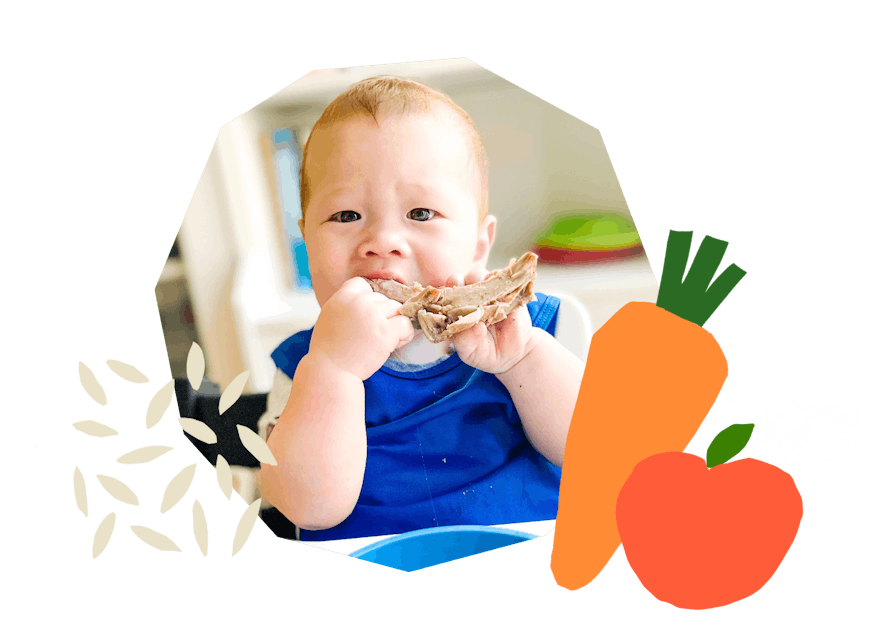
The Program Baby-Led Weaning with Katie Ferraro
A step-by-step digital program for starting solid foods safely and navigating the original 100 FIRST FOODS™ meal plan with baby-led weaning.
 EXPERT-LED, PROVEN APPROACH TO EATING REAL FOOD
EXPERT-LED, PROVEN APPROACH TO EATING REAL FOOD CONCISE VIDEO TRAININGS TO MASTER BABY-LED WEANING
CONCISE VIDEO TRAININGS TO MASTER BABY-LED WEANING 100 FIRST FOODS DAILY MEAL PLAN WITH FOOD PREP VIDEOS
100 FIRST FOODS DAILY MEAL PLAN WITH FOOD PREP VIDEOS
Baby-Led Weaning for Beginners Free Workshop
Is your baby ready to start solid foods, but you’re not sure where to start? Get ready to give your baby a solid foundation to a lifetime of loving real food…even if you’re feeling overwhelmed or confused about this next stage of infant feeding.
Get baby-led weaning recipes and tips delivered to your email inbox.

